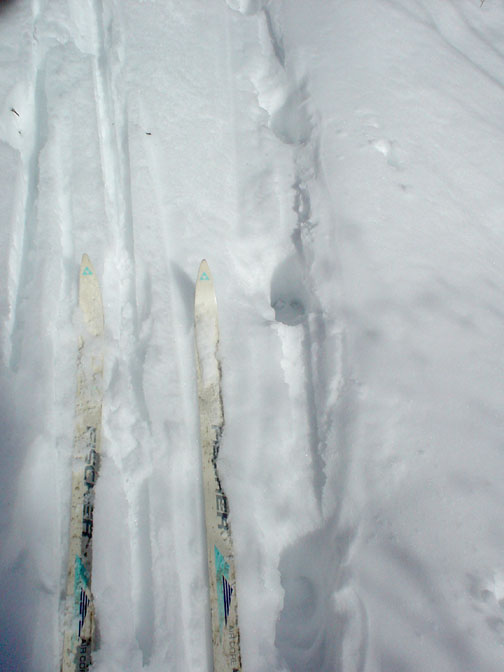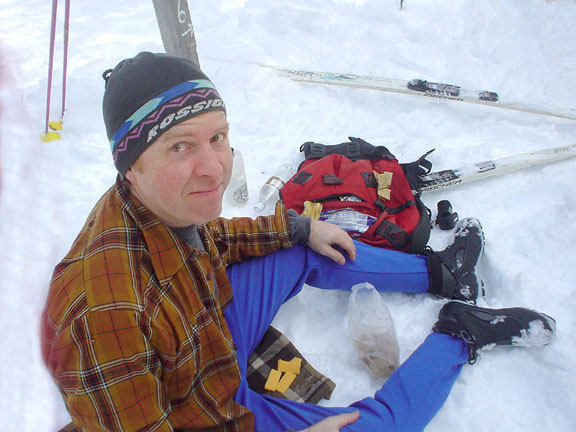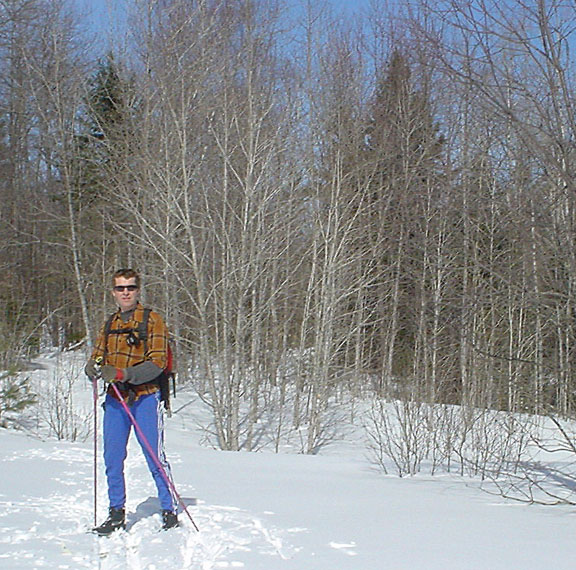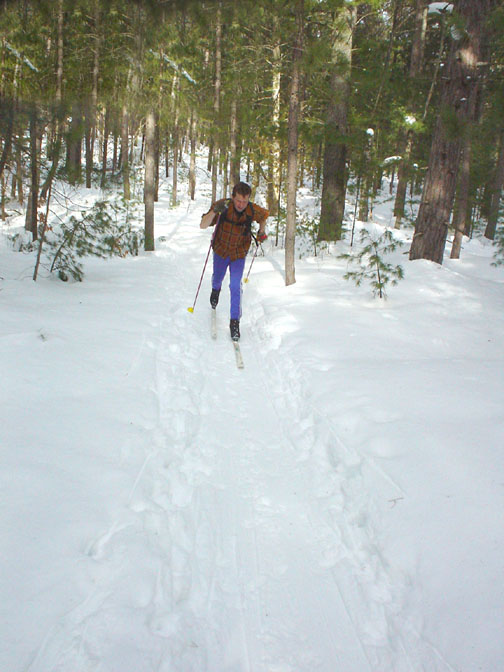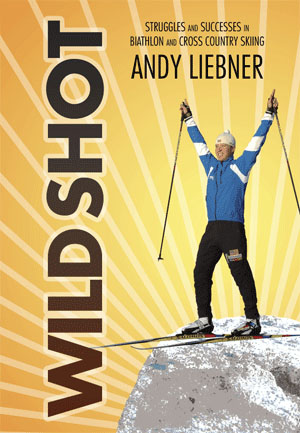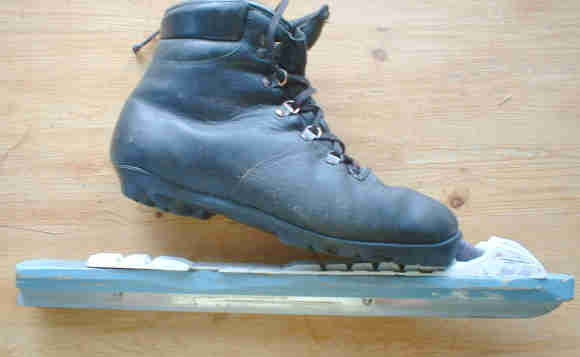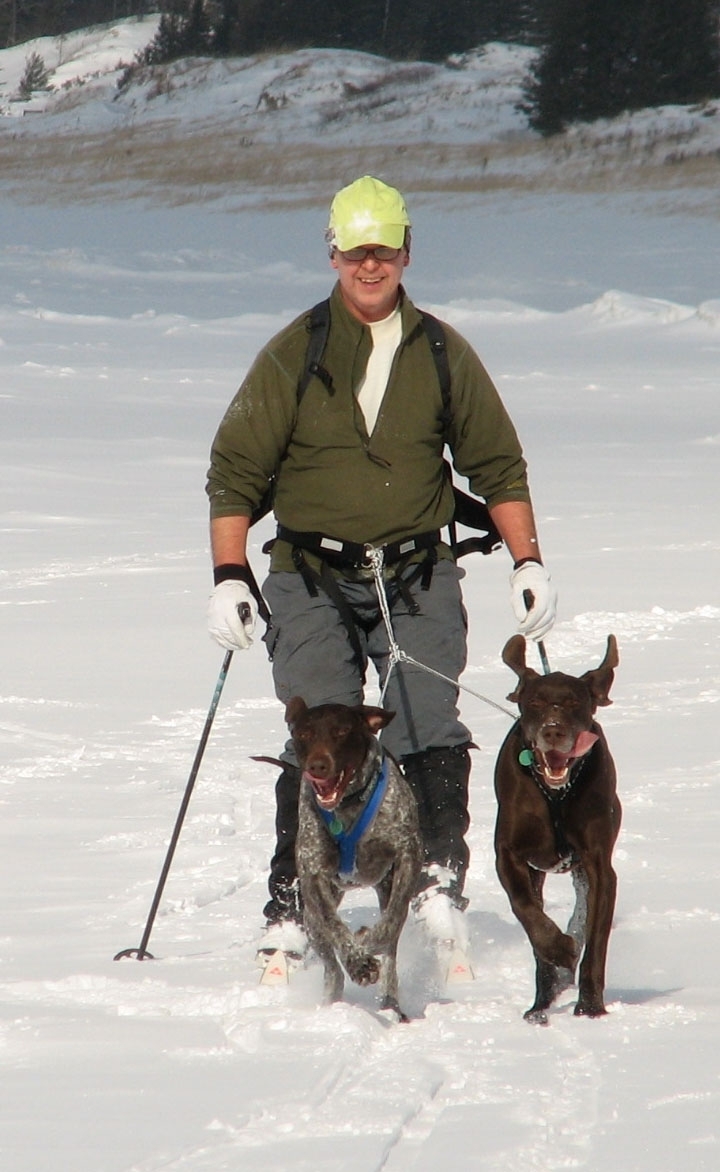When you’re not ready for a ski race, don’t go out hard. Man, why can’t I ever remember that rule.
This is a story of a painful ski race followed by a lovely ski tour…a tour where I got several wild ideas…
I entered the 30km Black Mountain Classic xc ski race last Saturday. It’s the last big regional race of the season. I figured I was as ready as I was going to get. It’s a lovely, narrow, wild traditional-style ski trail with a lot of scenic views. And it’s organized by a nice guy who works his butt off getting it ready then lines up with everyone and races—and usually wins!
There’s also a very nice restaurant in the boonies right overlooking the race start. The race starts on a frozen lake. The restaurant is on a hill above. It has a motel attached. It’s a great, affordable place to stay to do this race. And the big windows of the dining room are just lovely. They served up a wonderful lunch after the race. It was great sitting in their big sunny room, gabbing with skiers afterward, soaking up the solar power on such a nice blue-sky day.
I couldn’t find my old Adidas knickers so I had on a new retro outfit this time. We’ll see if it ended up looking nifty or not. I couldn’t tell.
The start went fine, but the first third of the race is very hilly. I hadn’t used my race skis yet this year and I hadn’t yet relaxed into using them right so they required a snappy zip to get them to grip on the early big uphills. I wasn’t going that hard, but even going only hard enough to keep moving on those uphills was too much and I went “under” and began suffering miserably a few minutes into it. Big mistake! That’ll wreck a whole outing, no problem. I backed off and tried to regroup but was already guaranteed to be in the misery-zone for the rest of the event. Dummy! Still, I had one fun uphill—everyone was taking it easy in one lane of the trail and I hopped into the other and glided past most of them. Smooth’n’easy—but just a little too brisk. A bit impatient. 5km later they went by me as I unraveled. Doh!
This is a 30k race that acts like a 50k. I heard of quite a few people bonking and suffering badly who normally know how to pace a race. I think it’s a deceptive course.
It took me 2:18 to finish—a time that I used to take to finish a 50k skate-ski race. I suspect that going out too fast cost me a lot of time—and a world of hurt.
A couple skiers I talked to after the race had an interesting reaction to it. I think they were still a little stunned. It’s a course that stuns even as you enjoy its beauty. I was sitting and comparing notes with Denny Paull, the organizer and guy who won, and we suddenly realized that he just had the best race of his life. It took an hour to pass after his own drooling sprint finish, and a group attempt at clear-thinking, for it to dawn on him. He threw his hands up: “Hey, that was my best race ever!” And he beamed—but he was so tired that the realization had been on time-delay. Same thing happened with another guy. I was congratulating him on doing so well. He looked at me, Yeah? I said Hey, you were way up there! He said, Yeah, I even beat so-and-so. I said, Right…you had A GREAT RACE. He paused then said, Hey…I did…I guess I did!
I think this race does that to people. Milan Biac, who usually wins these Michigan Cup races, said he’d only bonked once ever before (in 100’s of races) but that today he was seeing big purple spots instead of the trail at the end and then came unglued.
I had a couple interesting experiences myself. One was that after I was so tired I was almost ready to give up, well, I did just that. I thought: how can I just keep moving up these hills? I just want to take it easy and rest. How can I get grip without working or straining? And I discovered a way. I switched over to the long and relaxed Russian method instead of the zippy, compact Norwegian method I had been using. I let my head hang down. I even let my tongue hang out. And I started being able to go up the hills without hurting any further (which was good because my pain meter was at max). Then I started catching people. When the hills were too steep to glide up I tried my hardest to herringbone nicely—you really have to follow thru with the poles, as if you were skiing normally, to make h-bone work. Really, you just need to use the same style as when you’re gliding, only you shorten up and splay the tips. It worked pretty good. Everyone I was near had faster doublepoling than me, but I’d gain on the uphills. I also started kick-doublepoling with the same posture as I used when striding or h-boning. I was making as few changes as possible as I skied along on the cusp of passing out.
Ironically, last week I revised my “Why is XC Cool” essay to include the idea that XC racing is the art of skiing while tired, of working while not working. Too bad I didn’t take my own advice better: tired is one thing, blowing up is another.
I even got to do a bit of a sprint at the end. I was bumming because I’d caught up to several guys near the end and they were still in the vicinity. Ugh. I wondered if I could possibly spark up enough to nip anyone at the line. I’m an old enough ski-dog to know that if you’re going to finish within a couple seconds of someone it’s much better to be ahead. Well, the finish was on the big lake so Doug, the canoe-racer I was just ahead of, promptly applied a vicious sprint and put paid to any ideas I had of beating him.
After the finish I spread my jacket on the snow and layed down and almost fell asleep. The sun felt nice. I was the only person who did that—or skied so foolishly that they needed to. Someone said I looked spent as I was coming in. Yes.
When I was bending my legs to lay down I felt millions of tiny little pain crystals shatter along the tops of my thighs. Interesting.
It’s foolish to enter a challenging 30k race when you’re not prepared. Why couldn’t I have been smart and started easy? Smart…foolish…they don’t go together, do they?
I had been skiing a half hour a day on a local golf course to get ready for this race. At the end of each outing I felt quite tired and didn’t have the best technique. I thought it might be because I was using such slow skis. I thought that in a race my featherweight race skis would fly along effortlessly. Well, in the race the second thing that told me my goose was cooked was when I started falling apart at the exact same time as I did when I was training. Oh-oh… No free ride. Emergency, emergency!
Another thing I kind of decided (while napping in the snow) is that it would be a surefire great thing to just tour this race (or any other). Start at the back of the field and bring a fanny pack full of tasty treats. At the halfway point on this course is an open-front hut with grill overlooking Lake Huron. It’s great exercise just to go out and ski. Why risk blowing it? If you just ski a few times a week you’re ready to have an enjoyable day on even a long course. But your racing prospects are shaky in the extreme. Why do I risk such misery? (Memo to self. Lately I properly ski 1 in 4 races. I gotta change these stats. One thing is that I forgot to put on my heart rate monitor—it’s helped me slow down in the past when I look over at the dial and see it going off the chart.)
A Big Change of Tune the Next Day
So my friend Tim (who I rode up with) and I stayed at our teammate’s upnorth retirement house in Gaylord with other club members. We had some nice meals and R&R (single malt) after the race. The next day they headed home and probably got in a typical skate-ski hammerfest session on the way.
Tim and I decided to do something completely different and went out and did a picnic day of ski-touring at the Shinglemill Pathway wilderness trail 11 miles east of Vanderbilt, which was near where we stayed.
It was a gorgeous blue-sky day for ski-touring. Our trail went along the Pigeon River for several miles then up into stands of hilly hardwoods and poplars then back down to the river again for a 10-mile loop. (At the end of this report are some pics of our outing.)
Too bad the river was so pretty that I forgot to take any photos of when we skied along it! (And over a bridge across it.) We skied for 5 hours and had several food stops in the sun—two of our stops being big enough to qualify as picnics. Ah, yes, that’s more like it! Cheese’n’crackers and chocolate and nips of Jack. A bota of white wine was the only thing missing. (Besides just staying out there and camping.)
The ski-touring day made me pretty much decide to include a “something completely different” day after every race day. It would’ve been heavenly for canoeing as well. Either ski-touring or canoeing make great ways to recover from ski-racing—you get in a nice long day of fresh air and exercise and a great change of pace at the same time!
I got a couple other ideas along with this idea. (I’ve posted them separately as well, for folks who don’t need the “set and setting” that comes with them.)
Is Winter the new Summer?
The first was feeling just how wonderful it was out there in the snowy woods along the Pigeon river. There are 3 state campgrounds along this trail system. They all seemed to be semi-plowed. And not a single camper in them. (I now pause for effect.) In the summer these campgrounds would be absolutely full of people. There would be barking dogs and generators roaring. And screaming drunks. And fireworks. The river would be crowded with canoes and fishermen. The trails would be crowded. …So let us now return to our pristine ski tour. Hey, you could camp in the winter just as easy as in the summer. You’d only need a thicker sleeping bag and more clothes. Your campfire would do more good. You just couldn’t go swimming. Instead of biking or hiking, you go shoeing or skiing. Not much difference. Canoeing is equally perfect both times. Actually, it’s better in the winter: no bugs, no sweat. The water is crystalline and feels warm. Air is crisp and clear. The fishing is supposed to be better. You can even go hunting. Man, I’m gonna switch seasons!
Next big new idea…
Singletrack Fever!
I think it would be great to hold a series of Loppets on famous Michigan hiking trails. Some trails aren’t suitable for skiing, but many are. This would be doing what my recent “XC Singletrack” essay suggests: it’s classic skiing on narrow singletrack trails. Our day on the narrow Shinglemill trail verified that singletrack XC is a blast!
After skiing we were pleasantly exhausted, but before dinner we stopped and visited with Dick Fultz and Bob Smith at the Cross Country Ski Shop. (They had nice hippy-style bluegrass music playing on the shop’s sound-system. I think my senses were heightened after such a stellar day outdoors. It sounded even better than usual.) We told them about the Loppet idea. Dick said his local favorite ski trails in the Grayling area aren’t the groomed areas but the famous Mason Tract hiking trail along the South Branch of the Au Sable, and the Ogemaw trail near West Branch. I’m sure there are many other great trails like these around the state—which are mostly ignored by sport-skiers.
Dick is a top racer who is having a great season but he said I would’ve been proud of him because last week he did a 22-mile ski on the Mason Tract trail on his wood skis and considered it his best outing of the year. Well, maybe next time we can put the word out and some friends could join him.
Lesson: Ski events don’t only have to be at resorts! They don’t have to require fancy grooming! Wonderful trails deserve more publicity!
The Shinglemill Pathway was basically snowshoed-in along with some ski-action. The poling was soft but, really, it was great for classic ski-touring. Every now and then the trail went a ways on snowmobile trail, so we’d skate along. Skating would be fine in my Loppets: skate where it’s nice to; classic where that’s best (it might be fun to include a wide-open frozen lake crossing, too).
I’d think that putting on a Loppet could be pretty easy. I’d put up a website announcement that I was going to ski a certain trail of a certain distance on a certain day starting at a certain time and provide a map to print out and say that anyone else was welcome to join me and start their stopwatch if they liked (or not). It would be self-supported. What I would do, ideally, is arrange to have one or two people go out on snowshoes and do an out’n’back on the trail and tramp it in. With two shoers you could get a poling lane included. Then maybe have someone ski the course the day before, to get a track put in. If others are shoeing and skiing it in the meantime, all the better. I would suggest that people use touring skis and poles with big baskets. I’d provide how-to info for repairing broken poles along the trail (sapling plug) and suggest a basic safety/food/drink package that everyone should carry. If it became more popular we could include a buddy-system and/or make sure there was a snowmobile and cellphone around. (We were zipping down twisty hills with trees very close at hand.)
People could tour such an event and sightsee, or race it and get all the ski-skills challenges they could ask for. We’d have the tourists start at the back. We’d use the “track” rule where if someone wants to pass, the person in front has to step aside for a moment.
The Shinglemill Pathway loop is about 10 miles long. It has every kind of terrain, with no bad turns at all! There are obstacles, but not when you’re at speed. It’s super fun! There’s even a parks HQ lodge adjacent to the trail, with a big parking lot. We could have a bonfire and weenieroast afterward. A big pot of chili.
Faster, farther…or both?
Another thing I thought of—while skiing along admiring the elk tracks in our wilderness trail—was that it would be neat to put on an ultramarathon here in Michigan. At the Birkie trail they do the “24 Hours of Telemark,” and 24-hour races are popular in mt-biking. We Michigan skiers wouldn’t have to be so crazy. We could do a 12-hour race on the Vasa trail. It’s a famous, groomed trail with a campground on it. 27km per big loop. Dawn to dusk. How far could someone go? We might be surprised who would do well in such a race. It might bring a different crew to the front. It would mostly be a chance for folks to plain old see how far they can ski in a day. Without going too overboard. I think a top skier could go 100 miles. That would be 6 laps. Right on the nose. My imaginary plan for doing this in 12 hours would be to try to do a lap every 1hr:45min. Then for each lap you could stop at your campsite (with bonfire, etc.) and change clothes, then get a massage for 5 minutes, then take 5 minutes to sit down at a picnic table and eat, then get rolling again. Fun! : ) Maybe. That’s a 15.5km/hr pace to go 100 miles. Not superfast. But not slow. Seems a TAD too brisk. Like 13km/hr would make a world of difference in being a pace one could do all day, methinks. But what do I know! Nothing! It’s just an idea…
How about just farther…
Then there are the Canucks who have their venerable 120-mile two-day Canada Ski Marathon. It’s a point-to-point event that basically goes from Ottawa to Montreal. A classic route. For the Coureur du Bois. Hmmm, point-to-point. What could we do here in Michigan… Maybe the “Mackinaw Marathon”? —I looked on a map and the empty wilderness of the Mackinaw State Forest seems to stretch from the Boyne Mountain ski resort for a lot of miles down to the southwest to the Schuss Mountain resort. Looks like it would be at least twice as far as the 50k White Pine Stampede that runs nearby. Hmmm… Of all the goofy things to think of as I enjoy a day ski-touring along a lovely treat-stream…
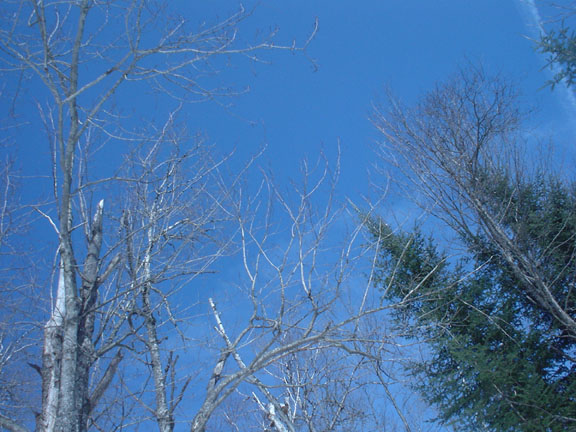
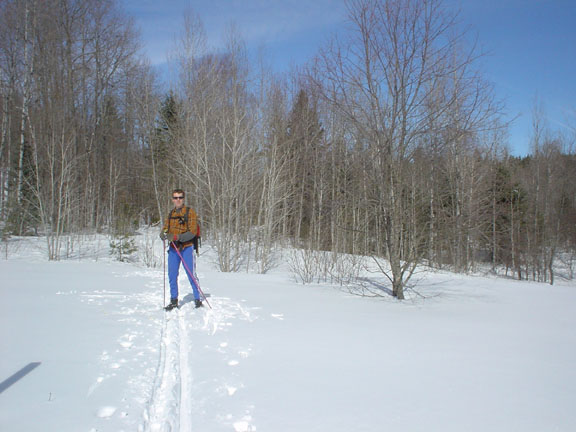
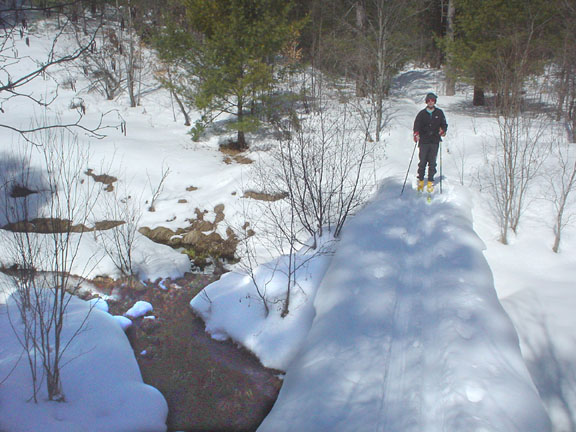
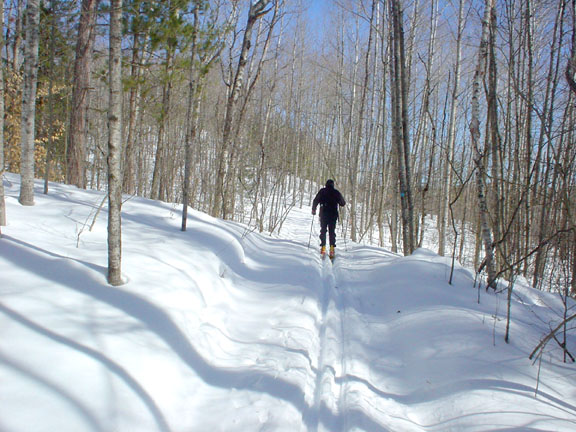
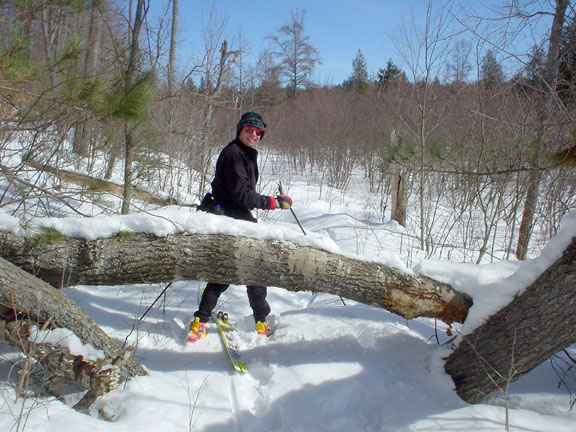
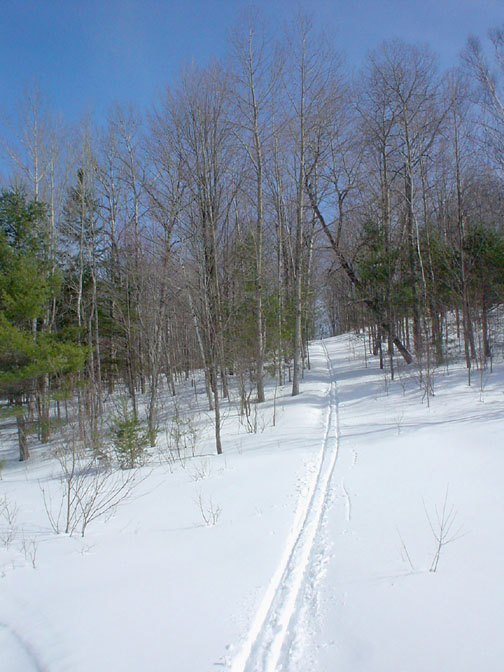
Next we see indications that a large ungulate wandered onto our trail. 5″x6″ tracks confirm the passage of a majestic Wapiti…
